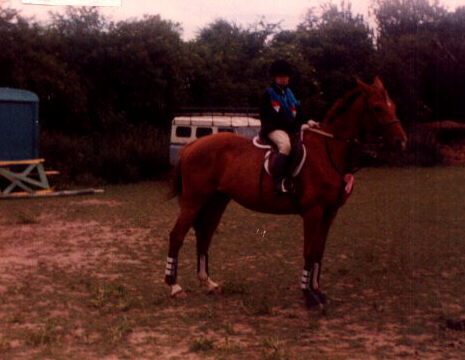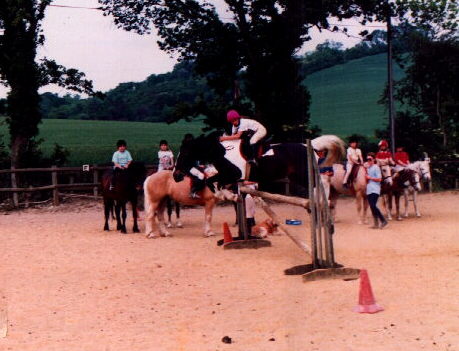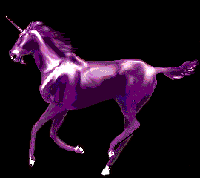TYPES OF HORSE
The following types are not breeds, in so much as that both parents were of similar heredity, but are physical types which could result from random breeding.

COB
The Cob is a stocky, weight-carrying small horse or large pony, ranging in height from 14 hands to 15.2 hands (1 hand = 4in or 10cm), suited to temperate climates, and of an intelligent, calm and amiable temper.
The hack, which could be considered a horse of the past if it were not still much-prized in horse-show classes, was the ideal excercise mount of the fashionable lady. It is a smallish, elegant horse, not more than 15.3 hands high; a lightweigh, slim-legged aristocrat of a subdued colour such as bay, brown or black (though chestnut and grey are acceptable) with perfect manners and smooth paces.
Prize-winning hacks in Europe are usally small Thoroughbreds, whereas in North America they are preponderantly Saddlebreds. In both cases they are charming, lightweight saddle horses.
The Show Pony is a child-sized Hack. For the benefit of children small to large, the pony comes in three sizes: up to 12.2 hands high, up to 13.2 hands high, and up to 14.2 hands high.
It is judged on its physical beauty, on its manners (which should be calm and confident, as befits an animal which will carry a young rider) and on its smoothness and elegance of movement at the walk, the trot and the canter. Refinement of physique and slimness of outline are much admired in this type of pony.
Prizewinners usally carry Welsh or thoroughbred bloodlines.

| | | | | | | | | |
The Eventer is a strong, sound, intelligent horse. It must be obedient enough to shine on the dressage test - the first phase of a three day event which tests the horse's harmony with its rider. It must be bold enough to survive the 27-odd km(17 odd miles)of the second thase, the endurance phase which tests both its stamina and its cross-country jumping ability. It must be brave and physically strong enough to complete the third phase of showjumping, despite being stiff |

| | | | | | | | | | and sore after its endurance test.
Eventers come in all shapes and sizes. the optimum is just over 16 hands high and, because of the speed needed to pass the endurance test without time penalties, the breeding is usually Thoroughbred or near Thoroughbred.
|
DRESSAGE HORSE
Any horse or pony of good physique and tractable temperament, given a skilled rider, is capable of learning dressage, and there are no standards to say that this or that sort of animal may not compete in this exciting sport. But to suceed at top level the Dressage Horse should be a big, imposing animal excluding personal presence and should not be of a colour (for example skewbald or spotted) to distract the eye from the movement of the horse as a whole. Successful dressage horses are usually bay, brown or chestnut, standing 16 - 18 hands high, and are often of Carriage Horse type.
Naturally good movement is essential. Dutch and German horses, such as Hanoverians and Oldenburgers, are most popular, with Thoroughbred blood for extra grace and fire.

The Show Jumper comes in every size and shape. There is no known way of breeding a horse which will happily leap over huge obstacles in cold blood. Consistently good ones must be sound of wind and limb, and usually have large hindquarters to generate power of jump.
But there are also little , slippy horses which can turn on a sixpence in speed competitions and spring like
 cats in Olympic classes.
cats in Olympic classes.
Top-class show jumpers give everything they have to jump unjumpable obstacles, often higher than thier heads. They delight in their prowess and relish applause for their work. The best go on long past the usual age of retirement for a horse.
The hunter is simply a horse suited to fox/drag hunting. It must be powerful enough to carry a rider all day long. For show purposes hunters are grouped as lightweights (which will carry up to 79kg/175lbs), middle-weights (up to 89kg/196lbs). There are also small hunters (14.2 -15.2hands high) and ladies' hunters (slightly finer in build).
Good hunters are brave, intelligent and obediant. Physically, the variety is enormous. Horses which wade over ploughed land need to be broad-hooved and sturdy, those which trick along hillside country need to be nimble and iron-lunged, and those which run over flatter grassland need to be swift and able to jump on the run.
The Polo Pony is a fast, quick-thinking and quick-turning animal, usually about 15 hands high (and so it is, strictly speaking, a horse rather than a pony). Breed is immaterial, though most of the best are Criollos or small Thoroughbreds.
Very good polo ponies are prima donnas and enjoy praise audience. The best play polo better than most of their riders.

| | | | | | | | | | RACEHORSE
The Racehorse, if a star, will give his all to get his nose in front at the winning post. Most racehorses are Thoroughbreds which have beebn bred for speed, but it is not always so.
Horses have been tested for speed for more than 5000 years - for about 4800 years before the Thoroughbred was evolved. |
Very early forms of racing, such as those practised by the Hitties, involvrd making horses extremelt thirsty and then loosing them to see which would be first to reach the water.
Modern racing includes trotting racing, Quarter horse racing, Arab racing and even - in America - Shetland Pony racing. As long as horses can be matched for speed, man will always gamble on the outcome.
| | | | | | | | | | | | | | | | | | | | COACH AND CARRIAGE HORSES |
Combined Driving, now becoming a popular sport, uses the most nimble and intelligent of the four-in-hand Coach horse types which, a century ago, were used to haul coach-loads of passengers over unmade roads.
Modern needs being recreational and sportive, these horses often lack the physique of the heftier carriage horses of times gone by.
Strongly-built Carriage Horses are still used for traditional ceremonies, such as the procession to and from the Stata Opening of the British Parliament, but these horses are chosen - and carefully trained - more for their calm ability to ignore crowd pressures than for their strength to pull today's increasingly-light carriages.






 cats in Olympic classes.
cats in Olympic classes.
